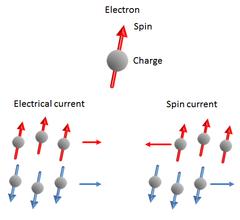Spintronics can lead to extremely fast, energy-efficient electronic circuits
http://www.desy.de/news/news_search/index_eng.html?openDirectAnchor=1247
http://www.desy.de/news/news_search/index_eng.html?openDirectAnchor=1247
The technology of spintronics is based on the intrinsic spin of electrons. In the medium term, it is set to replace electronics as the basis for technical devices. DESY scientist Lars Bocklage has discovered a new way of producing ultrafast spin currents. His calculations, which have now been published in the Physical Review Letters, suggest that the spin current can operate at terahertz frequencies – a thousand times faster than the speeds achievable at the moment.

Download [542KB, 2400 x 1200]
Such conventional electronics could be replaced by spintronics in the long term.
Such conventional electronics could be replaced by spintronics in the long term.
Like electrical currents, spin currents can be created by fluctuating magnetic fields. A spin current can also be “pumped” from a magnetic material into a neighbouring non-magnetic material; the spin current then also exists inside the other material for some distance. The effect is particularly pronounced when the magnetic material is excited by an external magnetic field at its resonant frequency. This typically lies around a few gigahertz, the frequency at which modern-day mobile communication devices or computer processors are operated. A gigahertz (GHz) corresponds to one billion oscillations per second, a terahertz (THz) is a thousand times faster, i.e. one trillion oscillations per second.

An electron carries a negative charge and a spin (upper picture). The spin can point in two different direction either up (red) or down (blue). Electrical currents transport charges (lower left). The spin directions cancel each other and only charges are transported by the electrical current. Spin currents transport spins. For a spin current (lower right) the electrons with different spin directions move in different directions. The charges cancel and only spins are transported. (picture: L. Bocklage).
No comments:
Post a Comment
Please share your thoughts. Leave a comment.